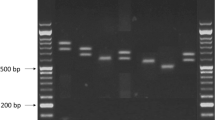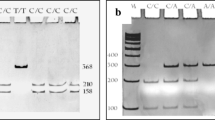Abstract
The 15-kDa selenoprotein (Sep15) is a selenocysteine-containing oxidoreductase in the endoplasmic reticulum that participates in disulfide-bond formation and protein folding control. The 3′-untranslated region (3′-UTR) contains two exclusively linked, polymorphic sites at positions 811 (C/T) and 1125 (G/A), which result in two functional haplotypes: 811C/1125G or 811T/1125A. The 811T/1125A variant occurs significantly more often in African-Americans as compared to Caucasians and has been linked to increased breast cancer risk in black women. We studied the 811C/T (rs5845) Sep15 gene polymorphism in 182 Caucasian women—83 breast cancer cases and 99 healthy controls—by pyrosequencing and polymerase chain reaction. Associations between allelic variants and clinico-pathological variables (e.g., age, stage of disease, tumor type, grading, and receptor status) were investigated. The genotype distribution in breast cancer patients (CC 63.9 %, CT 33.7 %, TT 2.4 %) and controls (69.7 %, CT 28.3 %, TT 2 %) showed no significant difference (OR 0.77, 95 % CI 0.41–1.42, p = 0.4). The overall low prevalence of the T allele was in accordance with that reported for Caucasians in previous studies. There was no significant association between 811C/T Sep15 polymorphism and any of clinico-pathological parameters. In conclusion, we are the first to report on 811C/T SEP 15 polymorphism in white breast cancer patients. Genotype variation within the 3′-UTR of the SEP 15 gene showed no association with breast cancer risk or clinico-pathological parameters in Caucasian women.

Similar content being viewed by others
References
Torre LA, Bray F, Siegel RL, Ferlay J, Lortet-Tieulent J, Jemal A. Global cancer statistics, 2012. CA Cancer J Clin. 2015;65:87–108.
Ferlay J, Steliarova-Foucher E, Lortet-Tieulent J, Rosso S, Coebergh JW, Comber H, et al. Cancer incidence and mortality patterns in Europe: estimates for 40 countries in 2012. Eur J Cancer. 2013;49:1374–403.
Eisemann N, Waldmann A, Katalinic A. Epidemiology of breast cancer—current figures and trends. Geburtshilfe Frauenheilkd. 2013;73:130–5.
Papp LV, Lu J, Holmgren A, Khanna KK. From selenium to selenoproteins: synthesis, identity, and their role in human health. Antioxid Redox Signal. 2007;9:775–806.
Davis CD, Tsuji PA, Milner JA. Selenoproteins and cancer prevention. Annu Rev Nutr. 2012;32:73–95.
Reszka E, Jablonska E, Gromadzinska J, Wasowicz W. Relevance of selenoprotein transcripts for selenium status in humans. Genes Nutr. 2012;7:127–37.
Babaknejad N, Sayehmiri F, Sayehmiri K, Rahimifar P, Bahrami S, Delpesheh A, et al. The relationship between selenium levels and breast cancer: a systematic review and meta-analysis. Biol Trace Elem Res. 2014;159:1–7.
Shchedrina VA, Zhang Y, Labunskyy VM, Hatfield DL, Gladyshev VN. Structure-function relations, physiological roles, and evolution of mammalian ER-resident selenoproteins. Antioxid Redox Signal. 2010;12:839–49.
Gladyshev VN, Jeang KT, Wootton JC, Hatfield DL. A new human selenium-containing protein. Purification, characterization, and cDNA sequence. J Biol Chem. 1998;273:8910–5.
Labunskyy VM, Ferguson AD, Fomenko DE, Chelliah Y, Hatfield DL, Gladyshev VN. A novel cysteine-rich domain of Sep15 mediates the interaction with UDP-glucose:glycoprotein glucosyltransferase. J Biol Chem. 2005;280:37839–45.
Jablonska E, Gromadzinska J, Sobala W, Reszka E, Wasowicz W. Lung cancer risk associated with selenium status is modified in smoking individuals by Sep15 polymorphism. Eur J Nutr. 2008;47:47–54.
Kumaraswamy E, Malykh A, Korotkov KV, Kozyavkin S, Hu Y, Kwon SY, et al. Structure-expression relationships of the 15-kDa selenoprotein gene. Possible role of the protein in cancer etiology. J Biol Chem. 2000;275:35540–7.
Labunskyy VM, Hatfield DL, Gladyshev VN. The Sep15 protein family: roles in disulfide bond formation and quality control in the endoplasmic reticulum. IUBMB Life. 2007;59:1–5.
Ferguson AD, Labunskyy VM, Fomenko DE, Araç D, Chelliah Y, Amezcua CA, et al. NMR structures of the selenoproteins Sep15 and SelM reveal redox activity of a new thioredoxin-like family. J Biol Chem. 2006;281:3536–43.
Labunskyy VM, Yoo MH, Hatfield DL, Gladyshev VN. Sep15, a thioredoxin-like selenoprotein, is involved in the unfolded protein response and differentially regulated by adaptive and acute ER stresses. Biochemistry. 2009;48:8458–65.
Hu YJ, Korotkov KV, Mehta R, Hatfield DL, Rotimi CN, Luke A, et al. Distribution and functional consequences of nucleotide polymorphisms in the 3′-untranslated region of the human Sep15 gene. Cancer Res. 2001;61:2307–10.
Nasr MA, Hu YJ, Diamond AM. Allelic loss at the SEP15 locus in breast cancer. Cancer Therapy. 2003;1:293–8.
Tsuji PA, Carlson BA, Naranjo-Suarez S, Yoo MH, Xu XM, Fomenko DE, et al. Knockout of the 15 kDa selenoprotein protects against chemically-induced aberrant crypt formation in mice. PLoS One. 2012;7:e50574.
Tsuji PA, Naranjo-Suarez S, Carlson BA, Tobe R, Yoo MH, Davis CD. Deficiency in the 15 kDa selenoprotein inhibits human colon cancer cell growth. Nutrients. 2011;3:805–17.
Apostolou S, Klein JO, Mitsuuchi Y, Shetler JN, Poulikakos PI, Jhanwar SC, et al. Growth inhibition and induction of apoptosis in mesothelioma cells by selenium and dependence on selenoprotein SEP15 genotype. Oncogene. 2004;23:5032–40.
Hudson TS, Carlson BA, Hoeneroff MJ, Young HA, Sordillo L, Muller WJ, et al. Selenoproteins reduce susceptibility to DMBA-induced mammary carcinogenesis. Carcinogenesis. 2012;33:1225–30.
Kumaraswamy E, Carlson BA, Morgan F, Miyoshi K, Robinson GW, Su D, et al. Selective removal of the selenocysteine tRNA [Ser]Sec gene (Trsp) in mouse mammary epithelium. Mol Cell Biol. 2003;23:1477–88.
Sutherland A, Kim DH, Relton C, Ahn YO, Hesketh J. Polymorphisms in the selenoprotein S and 15-kDa selenoprotein genes are associated with altered susceptibility to colorectal cancer. Genes Nutr. 2010;5:215–23.
Penney KL, Schumacher FR, Li H, Kraft P, Morris JS, Kurth T, et al. A large prospective study of SEP15 genetic variation, interaction with plasma selenium levels, and prostate cancer risk and survival. Cancer Prev Res (Phila). 2010;3:604–10.
Karunasinghe N, Han DY, Goudie M, Zhu S, Bishop K, Wang A, et al. Prostate disease risk factors among a New Zealand cohort. J Nutrigenet Nutrigenom. 2012;5:339–51.
Geybels MS, Hutter CM, Kwon EM, Ostrander EA, Fu R, Feng Z, et al. Variation in selenoenzyme genes and prostate cancer risk and survival. Prostate. 2013;73:734–42.
Tong D, Schneeberger C, Czerwenka K, Schmutzler RK, Speiser P, Kucera E, et al. Messenger RNA determination of estrogen receptor, progesterone receptor, pS2, and plasminogen activator inhibitor-1 by competitive reverse transcription-polymerase chain reaction in human breast cancer. Clin Cancer Res. 1999;5:1497–502.
Rodriguez S, Gaunt TR, Day IN. Hardy-Weinberg equilibrium testing of biological ascertainment for Mendelian randomization studies. Am J Epidemiol. 2009;169:505–14. http://www.oege.org/software/hwe-mr-calc.shtml. Accessed 24 Apr 2014.
Lowry R. VassarStats: website for statistical computation. http://vassarstats.net. Accessed 6 Aug 2014
Reszka E, Gromadzinska J, Jablonska E, Wasowicz W, Jablonowski Z, Sosnowski M. Level of selenoprotein transcripts in peripheral leukocytes of patients with bladder cancer and healthy individuals. Clin Chem Lab Med. 2009;47:1125–32.
Steinbrecher A, Méplan C, Hesketh J, Schomburg L, Endermann T, Jansen E, et al. Effects of selenium status and polymorphisms in selenoprotein genes on prostate cancer risk in a prospective study of European men. Cancer Epidemiol Biomarkers Prev. 2010;19:2958–68.
Méplan C, Hughes DJ, Pardini B, Naccarati A, Soucek P, Vodickova L, et al. Genetic variants in selenoprotein genes increase risk of colorectal cancer. Carcinogenesis. 2010;31:1074–9.
Jaworska K, Gupta S, Durda K, Muszyńska M, Sukiennicki G, Jaworowska E, et al. A low selenium level is associated with lung and laryngeal cancers. PLoS One. 2013;8:e59051.
Wolff MS, Britton JA, Wilson VP. Environmental risk factors for breast cancer among African-American women. Cancer. 2003;97(1 Suppl):289–310.
Bernstein L, Teal CR, Joslyn S, Wilson J. Ethnicity-related variation in breast cancer risk factors. Cancer. 2003;97(1 Suppl):222–9.
Tea MK, Fan L, Delancey JW, Staudigl C, Steurer S, Lang C, et al. Is breast cancer in young Asian women more aggressive than in Caucasians? A cross-sectional analysis. Tumour Biol. 2013;34:2379–82.
Pei J, Li F, Wang B. Single nucleotide polymorphism 6q25.1 rs2046210 and increased risk of breast cancer. Tumour Biol. 2013;34:4073–9.
Zhou LP, Yao F, Luan H, Wang YL, Dong XH, Zhou WW, et al. CYP3A4*1B polymorphism and cancer risk: a HuGE review and meta-analysis. Tumour Biol. 2013;34:649–60.
Zhou ZC, Wang J, Cai ZH, Zhang QH, Cai ZX, Wu JH. Association between vitamin D receptor gene Cdx2 polymorphism and breast cancer susceptibility. Tumour Biol. 2013;34:3437–41.
da Rocha TJ, Korb C, Schuch JB, Bamberg DP, de Andrade FM, Fiegenbaum M. SLC30A3 and SEP15 gene polymorphisms influence the serum concentrations of zinc and selenium in mature adults. Nutr Res. 2014;34:742–8.
da Rocha TJ, Blehm CJ, Bamberg DP, Fonseca TL, Tisser LA, de Oliveira Junior AA, et al. The effects of interactions between selenium and zinc serum concentration and SEP15 and SLC30A3 gene polymorphisms on memory scores in a population of mature and elderly adults. Genes Nutr. 2014;9:377.
Combs Jr GF, Watts JC, Jackson MI, Johnson LK, Zeng H, Scheett AJ, et al. Determinants of selenium status in healthy adults. Nutr J. 2011;10:75.
Karunasinghe N, Han DY, Zhu S, Yu J, Lange K, Duan H, et al. Serum selenium and single-nucleotide polymorphisms in genes for selenoproteins: relationship to markers of oxidative stress in men from Auckland, New Zealand. Genes Nutr. 2012;7:179–90.
Pestitschek M, Sonneck-Koenne C, Zakavi SR, Li S, Knoll P, Mirzaei S. Selenium intake and selenium blood levels: a novel food frequency questionnaire. Wien Klin Wochenschr. 2013;125:160–4.
Acknowledgments
RW was supported by the Ernst Mach Grant of the Austrian Exchange Service (ÖAD) financed by the Austrian Ministry of Education, Science and Culture (BMBWK). We thank Eva Obermayr, PhD, Grazyna Dudek, and Ingrid Schiebel for their technical assistance.
Conflicts of interest
None
Author information
Authors and Affiliations
Corresponding author
Rights and permissions
About this article
Cite this article
Watrowski, R., Castillo-Tong, D.C., Fabjani, G. et al. The 811 C/T polymorphism in the 3′ untranslated region of the selenoprotein 15-kDa (Sep15) gene and breast cancer in Caucasian women. Tumor Biol. 37, 1009–1015 (2016). https://doi.org/10.1007/s13277-015-3847-7
Received:
Accepted:
Published:
Issue Date:
DOI: https://doi.org/10.1007/s13277-015-3847-7




